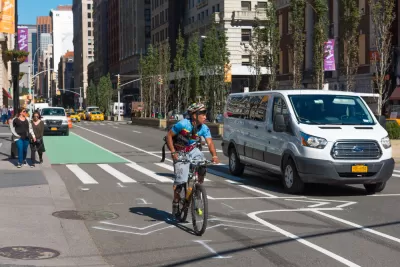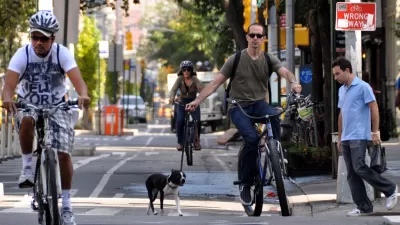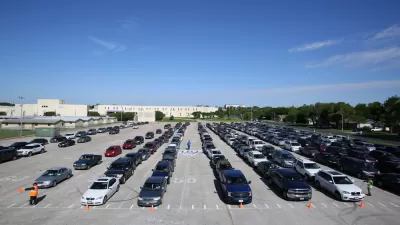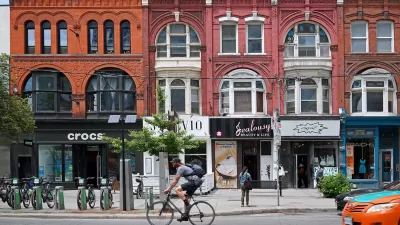Could the pandemic be a tipping point for a century of car-centric planning in New York City's to give way to a more bike-friendly city?

New York Times architecture critic Michael Kimmelman surveys the changing politics of bike planning in New York City, as evidenced by a slew of innovations implemented as public health and economic stimulus actions during the pandemic. Kimmelman starts off by describing recent planning developments, all documented previously Planetizen, as a glimmer of hope for a change to planning in the city.
- 'Open Restaurants on Open Streets' Program Announced in NYC (July 6, 2020)
- Electric Bikes and Scooters Legalized in New York City (June 29, 2020)
- First New Bridge to Manhattan in Decades Proposed Just for Pedestrians and People on Bikes (June 25, 2020)
- Bike-Centered Brooklyn Bridge Redo Under Consideration (June 22, 2020)
- Five Borough Bikeway Plan Released (June 18, 2020)
- Court Decision Clears the Way for East River Greenway Bike Bridge (May 12, 2020)
- Signal Priority in N.Y.C. to Make Streets Safer for Cyclists (November 6, 2019)
According to Kimmelman, the city is faced with two particularly ambitious potential paths forward to ensure a more bike-friendly future: the Regional Plan Association's Five Borough Bikeway Plan and the Queens Ribbon Bridge. The time is now to act on plans like these, argues Kimmelman:
Getting through this whole crisis depends on city leaders’ capacity to think ahead, not hunker down. Robert Moses, New York’s storied planning czar, plotted during the depths of the Depression so he could be ready when the money materialized. Whatever else one might say about Moses, he knew how to get stuff done.
By contrast, New York today has become good at shooting down new ideas, celebrating defeat over compromise, pointing out why any big, costly initiative is not worth pursuing because something else also needs doing, as if a great city shouldn’t find ways to do more than one thing at a time.
The city has changed before, according to one of the big statements included in this article. The current economic and public health crisis could provide another tipping point.
FULL STORY: New York as a Biking City? It Could Happen. And It Should.

Planetizen Federal Action Tracker
A weekly monitor of how Trump’s orders and actions are impacting planners and planning in America.

Maui's Vacation Rental Debate Turns Ugly
Verbal attacks, misinformation campaigns and fistfights plague a high-stakes debate to convert thousands of vacation rentals into long-term housing.

San Francisco Suspends Traffic Calming Amidst Record Deaths
Citing “a challenging fiscal landscape,” the city will cease the program on the heels of 42 traffic deaths, including 24 pedestrians.

Amtrak Rolls Out New Orleans to Alabama “Mardi Gras” Train
The new service will operate morning and evening departures between Mobile and New Orleans.

The Subversive Car-Free Guide to Trump's Great American Road Trip
Car-free ways to access Chicagoland’s best tourist attractions.

San Antonio and Austin are Fusing Into one Massive Megaregion
The region spanning the two central Texas cities is growing fast, posing challenges for local infrastructure and water supplies.
Urban Design for Planners 1: Software Tools
This six-course series explores essential urban design concepts using open source software and equips planners with the tools they need to participate fully in the urban design process.
Planning for Universal Design
Learn the tools for implementing Universal Design in planning regulations.
Heyer Gruel & Associates PA
JM Goldson LLC
Custer County Colorado
City of Camden Redevelopment Agency
City of Astoria
Transportation Research & Education Center (TREC) at Portland State University
Jefferson Parish Government
Camden Redevelopment Agency
City of Claremont





























